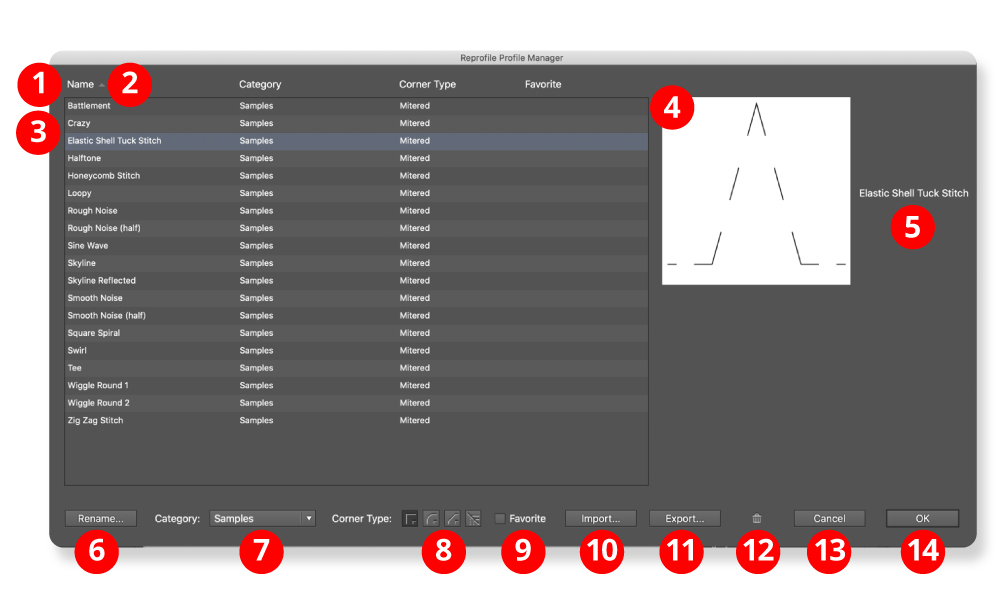Profile Manager
The Profile Manager is used for editing the Profile Library and can be located via Reprofile Panel Flyout Menu > Manage Profiles... or by using the Open Profile Manager button at the bottom of the panel. There is some overlap with the Profile Attributes Editor, which is intended for editing metadata associated with a single profile. Profile Manager operates on the library as a whole.
The "Sample profiles", which are automatically added when Reform is first installed, can be edited or deleted like profiles you create yourself. When all profiles are deleted, the Sample profiles will be reset. Profiles can also be exported or imported in an open xml format. This allows the sharing of profiles and the creation of backup files.

Reprofile Profile Manager
1. The field headers
The field headers sort on the field when clicked. If the field is already selected, the sort order is toggled.
2. Sort order arrow
Shows whether the sort is ascending or descending.
3. The Profile list
Every profile in the library is listed. It is possible to select a single profile or a group of profiles. Profile Manager edit operations always operate on the selection.
Fields are:
Name: the name of the profile
Category: the category to which the profile is assigned, or “None”.
Corner type: behaviour at sharp joins in the target path.
Favorite: set if the profile is a favorite
4. Profile thumbnails
Shows up to sixteen profiles for preview. Profiles have rubber sheet geometry so aspect ratio with drawn artwork will not be preserved. If width is much greater than height, it decides intelligently whether to display the profile as repeating elements or to stretch it.
5. Names
Profile names displayed here to identify the thumbnails.
6. Rename button
Brings up a dialog to rename the selected profile. (The Profile Attributes Editor may also be used to set the name).

Reprofile Flyout Menu
7. Category dropdown
Sets the category of the selected profiles. The “New…” option brings up a dialog to create a new category (the Profile Attributes Editor may also be used). The “Manage…” option brings up the Category Manager dialog, which allows the renaming, deletion, or creation of categories (not available from the Profile Attributes Editor).
8. Corners buttons
When reprofiling a path with an abrupt change in path direction, the corner type specifies how the reprofiled path bends around the original corner.
9. Favorite checkbox
To mark a profile as a favorite for easy selection.
10. Import button
Brings up a dialog to import profiles from xml files. The library stores the profiles as a flat list, so names cannot be duplicated. It will attempt to intelligently resolve name conflicts.
11. Export button
Brings up a dialog to export the selected profiles. Profiles are exported as open xml files. The profile name is stored in the xml data so the name of the file can be changed without affecting the library name.
12. Delete button
Deletes the selected profiles. Delete every profile to reset the library to the original sample profiles on next start-up.
13. Cancel button
Cancels every library editing operation, including import operations, but not export operations.
14. OK button
Accept the edits and updates the profile library. This will purge the undo list if the Reprofile tool is active.
